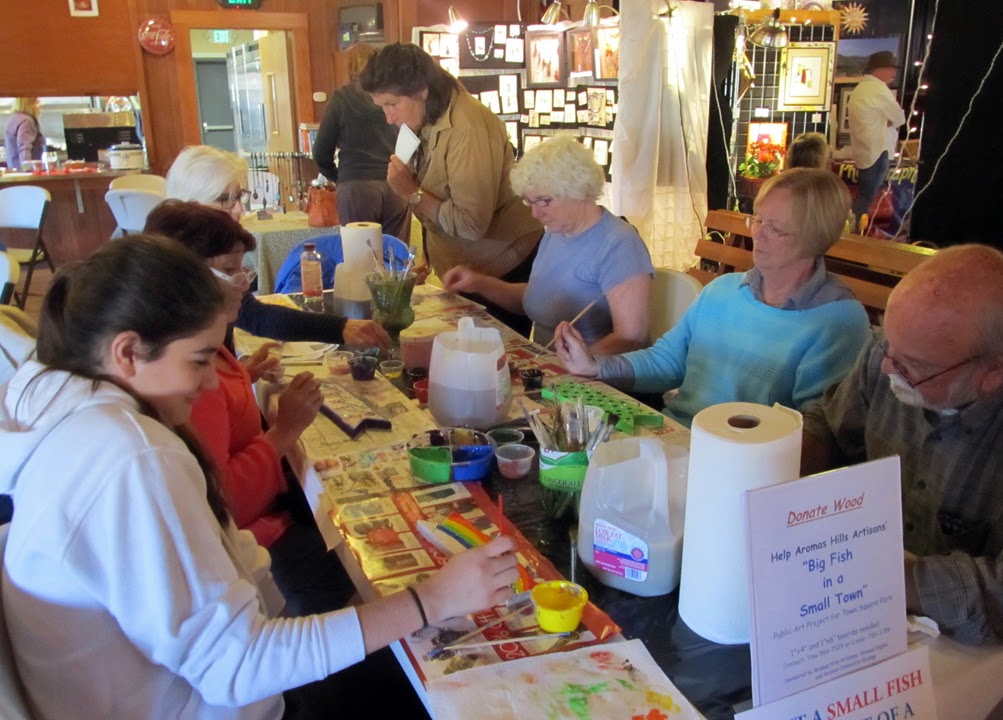Big Fish
Gamcheon Culture Village in Busan, South Korea inspires community art in Aromas, California
Gamcheon Culture Village in Busan, South Korea inspires community art in Aromas, California
Originally published May 1, 2015 in the Santa Cruz Sentinel
Round my hometown
Ooh the people I've met
Are the wonders of my world
Ooh the people I've met
Are the wonders of my world
–Adele
 |
| The “Big
Fish” was created by over 200 residents and friends of Aromas in the fall and
winter of 2014-15. and installed in the Aromas Town Square Park on April 12, 2015. |
So what is this “sense of community” they are chasing and why is it so
important? A recent article by Virginia Sole-Smith in Real Simple magazine makes
the case that face-to-face connections are rapidly declining in favor of social
networking and isolation. And the daily cycle of home-to-work-to-couch-to-bed keeps
us unconnected, distrustful and even, unhealthy.
Sole-Smith shares some disheartening statistics:
- The last quarter of the 20th
century saw a drop of a 33 percent in the number of people who regularly
invite friends over and a 58 percent drop in the number who join community
clubs and actually attend meetings.
- In the 1960s, half of Americans said they
trusted other people, even strangers; less than a third say so today.
- 25 percent of us lack a single close confidant
(defined as someone with whom you can discuss “important matters”), while
50 percent of us are just one friend away from social isolation—and social
isolation is a strong predictor of premature death.
One family profiled by Sole-Smith, however, took a dramatic leap of
faith and used Facebook to broaden
their face-to-face associations. Feeling like they never saw their friends and
neighbors between the demands of work and home, the family posted an open
invitation on Facebook for Friday night spaghetti and meatball dinners at their
home. Anyone was welcome at their table, and they kept the meal prep and
housekeeping to a minimum. The priority was spending more time with their
village. (Now the idea has gone global, and stories of its success are posted
on FridayNightMeatballs.com, whose motto is “Building community, one dinner at
a time.”) I’m truly astounded by the willingness and trust it takes to make
this kind of continuing commitment in the name of community.
Last year, my husband discovered another great example of community-building
on the other side of the globe. We flew to South Korea—the country our
20-year-old daughter has chosen to call home after a ten-month stay there as a Watsonville
Rotary-sponsored exchange student in 2011-12. We visited several cities, but
our favorite was Busan—a modern metropolis of 3.6 million at the southern-most
tip of the Korean peninsula.
 |
| Gamcheon Culture Village after the Korean War. |
 |
| Gamcheon Culture Village today. |
In addition to experiencing the beautiful beaches, glamorous department stores, fascinating fish markets, cat cafes, and sweet potato pizza, we also visited Gamcheon Culture Village – a residential community of colorful, box-shaped homes terraced on a steep hillside overlooking the southern coastline. In contrast to Busan’s glittering high-rises, Gamcheon Culture Village has retained its traditional look and identity, housing many of Busan’s less-affluent since the early 20th century. What makes it a tourist destination is the art-themed make-over it received in 2009-10, when the Ministry of Culture, Sports and Tourism in South Korea invited artists and art students to add murals, sculpture and art installations to the village.
Most impressive to me was the fact that much of the artwork was created collaboratively
by artists and village residents. One of the best products of this teamwork was
the painted wooden fish, posted along the narrow pathways to guide tourists through
the hillside labyrinth of art and homes. These same small fish were also
arranged on a tall retaining wall in the shape of a very large fish, creating a
colorful backdrop for tourist selfies.
 |
| Aromas School fifth graders painted fish for the project. |
Before our trip to South Korea, one of the community-builders in my own
hometown came to my arts group and proposed that we create an art installation
for Aromas’s Town Square Park. We scratched our heads and worried about
vandalism.
After my trip to South Korea, I showed photos of Gamcheon Culture
Village and proposed that Aromas, as a community, could create a large fish
mosaic of our own. With the guidance and commitment of a few dedicated volunteers,
and the participation of about 200 community members and their friends, we were
able to paint 350 fish over a five-month period and finally install the big
fish in the park last month.
 |
| The Aromas community had several opportunities
to paint fish at various Grange events such as the pancake breakfasts and holiday arts festival. |
Just last weekend, I was thrilled when our spring talent show, Aromas
Live, used an image of the Big Fish on the program cover and recognized its
completion. Perhaps the Big Fish will serve as a symbol of a small town devoted
to creating a sense of community. Perhaps, as we drive by the park on our way
home, we will now turn our heads and smile at the colorful reminder of how
fortunate we are to live in a place where we feel like we truly belong.
 |
| Wet fish dry in the sun—a contribution to the
Aromas Big Fish from an intercession arts class at our local Anzar High School. |

